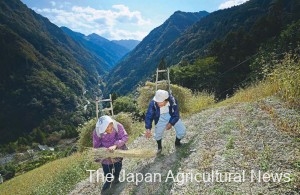TOKUSHIMA, Dec. 4 — The Nishi-Awa area in the western part of Tokushima Prefecture is surrounded by steep mountains at high altitudes of between 100 and 1,000 meters above sea level, and the slopes are so steep that a unique farming method has been adopted to cultivate them as they are instead of converting them into terraced fields.
The unique techniques and wisdom have been handed down for more than 400 years to grow indigenous varieties of buckwheat and millet.
In March 2018, the steep slope land agricultural system of Nishi-Awa was designated as a Globally Important Agricultural Heritage System (GIAHS) by the Food and Agriculture Organization of the United Nations.
Haruki Nishiokada, 82, and his wife Setsuko, 75, inherit the farming method on the slopes 350 meters above sea level in the Sarukai community in the Tokshima Prefecture town of Tsurugi.
Walking briskly on the steep slopes, Haruki said with a smile, “Having lived here for 80 years, it is easier for me to walk on slopes rather than on flat land.”
Bundles of kaya grass, harvested and piled up in a conical shape here and there on the fields, are called kayaguro.
By plowing the dried grass in the fields, soil erosion can be prevented and the soil is fertilized.
Farmers also use a farming tool called sarae to return the soil that slid down the slopes back up, a practice unique to farming on sloping ground. They continue maintaining the fields every day to keep the quality of the soil.
Setsuko, who has been married to Haruki for 50 years and has always been working in the fields with him, said, “You can’t plant nor harvest buckwheat only by yourself. We do everything together.”
Haruki agreed and said, “This is where the spirit of mutual help comes in.”
After the area earned the GIAHS designation, people turned a fresh eye on the district, giving a boost to the community on steep slopes.
Shinji Taguchi, 59, who returned from outside the prefecture to his hometown Higashimiyoshi, a town in the Nishi-Awa area, retired early and started engaging in farming in 2017.
Taguchi adopts farming with reduced pesticide use and his colorful vegetables are popular on e-commerce sites.
He contributes to the community by coming up with various business ideas such as offering agricultural experience programs including harvesting and farm stays, as well as holding lectures on measures to prevent wildlife damage.
“I want to prove that agriculture can be fun depending on how you do it, and share my experiences and knowledge with people thinking about starting farming,” Taguchi said.
In the landscapes of Nishi-Awa that seem straight out of folk tales, people are working to maintain the mountains that would give them blessings in return.
Such a relationship between people and nature that lasted for 400 years would certainly have the power to get people outside the area involved as well.


